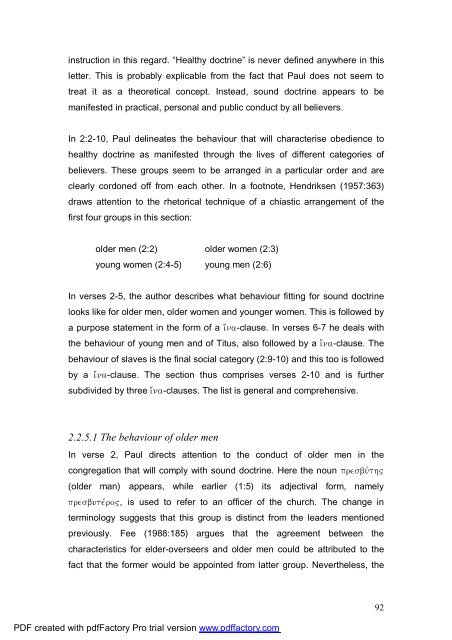A Text centred rhetorical analysis of Paul's Letter to Titus
A Text centred rhetorical analysis of Paul's Letter to Titus
A Text centred rhetorical analysis of Paul's Letter to Titus
Create successful ePaper yourself
Turn your PDF publications into a flip-book with our unique Google optimized e-Paper software.
instruction in this regard. “Healthy doctrine” is never defined anywhere in this<br />
letter. This is probably explicable from the fact that Paul does not seem <strong>to</strong><br />
treat it as a theoretical concept. Instead, sound doctrine appears <strong>to</strong> be<br />
manifested in practical, personal and public conduct by all believers.<br />
In 2:2-10, Paul delineates the behaviour that will characterise obedience <strong>to</strong><br />
healthy doctrine as manifested through the lives <strong>of</strong> different categories <strong>of</strong><br />
believers. These groups seem <strong>to</strong> be arranged in a particular order and are<br />
clearly cordoned <strong>of</strong>f from each other. In a footnote, Hendriksen (1957:363)<br />
draws attention <strong>to</strong> the <strong>rhe<strong>to</strong>rical</strong> technique <strong>of</strong> a chiastic arrangement <strong>of</strong> the<br />
first four groups in this section:<br />
older men (2:2) older women (2:3)<br />
young women (2:4-5) young men (2:6)<br />
In verses 2-5, the author describes what behaviour fitting for sound doctrine<br />
looks like for older men, older women and younger women. This is followed by<br />
a purpose statement in the form <strong>of</strong> a i{na-clause. In verses 6-7 he deals with<br />
the behaviour <strong>of</strong> young men and <strong>of</strong> <strong>Titus</strong>, also followed by a i{na-clause. The<br />
behaviour <strong>of</strong> slaves is the final social category (2:9-10) and this <strong>to</strong>o is followed<br />
by a i{na-clause. The section thus comprises verses 2-10 and is further<br />
subdivided by three i{na-clauses. The list is general and comprehensive.<br />
2.2.5.1 The behaviour <strong>of</strong> older men<br />
In verse 2, Paul directs attention <strong>to</strong> the conduct <strong>of</strong> older men in the<br />
congregation that will comply with sound doctrine. Here the noun presbuvth~<br />
(older man) appears, while earlier (1:5) its adjectival form, namely<br />
presbutevro~, is used <strong>to</strong> refer <strong>to</strong> an <strong>of</strong>ficer <strong>of</strong> the church. The change in<br />
terminology suggests that this group is distinct from the leaders mentioned<br />
previously. Fee (1988:185) argues that the agreement between the<br />
characteristics for elder-overseers and older men could be attributed <strong>to</strong> the<br />
fact that the former would be appointed from latter group. Nevertheless, the<br />
PDF created with pdfFac<strong>to</strong>ry Pro trial version www.pdffac<strong>to</strong>ry.com<br />
92

















